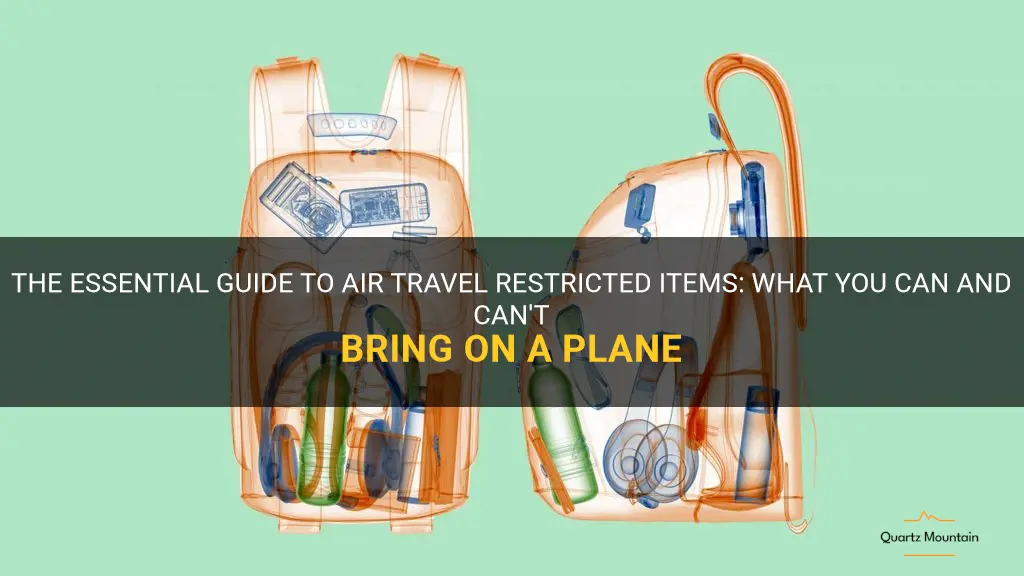
Air travel has become an integral part of our modern lives, allowing us to explore the world and connect with people from different cultures. However, when it comes to air travel, there are certain items that are restricted and prohibited from being carried onboard. These restricted items are essential to ensure the safety and security of passengers and crew members. From sharp objects to flammable substances, understanding the restrictions on air travel can help us have a smoother and safer journey. So, let's delve into the world of air travel restricted items and explore the reasons behind these regulations.
What You'll Learn
- What are some common examples of air travel restricted items?
- Can you bring any type of liquids on a plane, or are there restrictions?
- Are there limitations on the size or quantity of personal care items allowed in carry-on luggage?
- Are there any restrictions regarding the transportation of sharp objects or weapons on a plane?
- How does the list of air travel restricted items differ between domestic and international flights?

What are some common examples of air travel restricted items?
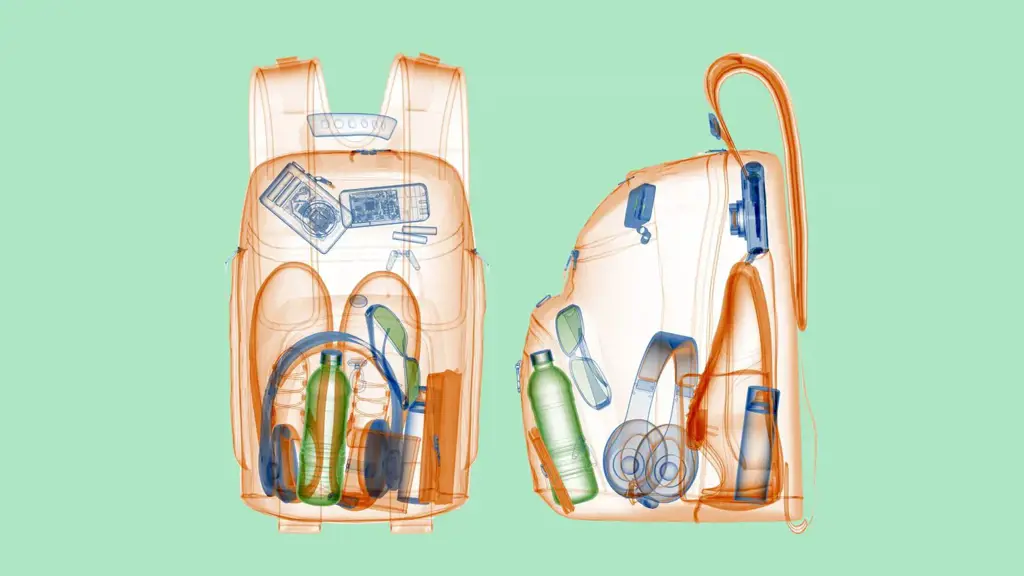
Air travel provides a convenient means of transportation, allowing people to reach their intended destinations quickly and efficiently. However, there are certain rules and regulations that passengers must adhere to in order to maintain the safety and security of air travel. One such regulation concerns the restricted items that passengers are prohibited from carrying on board.
The restrictions on air travel vary depending on the country and airline, but there are several common examples of restricted items that are universally prohibited on most flights. These include:
- Liquids and Gels: Passengers are typically limited to carrying small amounts of liquids and gels in containers that are 3.4 ounces (100 milliliters) or less per item. These must be placed in a clear, resealable plastic bag and presented separately for inspection at the security checkpoint. This restriction applies to items such as toiletries, beverages, and other liquids and gels.
- Sharp Objects: Objects such as knives, scissors, and razor blades are strictly prohibited in carry-on baggage. These items are considered potential weapons and must be stowed in checked luggage.
- Firearms and Ammunition: Passengers are generally prohibited from carrying firearms and ammunition in their carry-on bags. However, these items may be transported in checked luggage as long as they are properly declared and packaged according to airline and regulatory requirements.
- Flammable Items: Flammable materials such as lighter fluid, gasoline, and aerosol cans are strictly prohibited on flights. These items pose a significant fire hazard and must be left behind or packed in checked luggage if necessary.
- Explosives and Incendiary Devices: Explosive materials, fireworks, and incendiary devices are obviously not allowed on flights. These items pose a serious threat to the safety of passengers and crew members and are strictly prohibited.
- Sporting Goods: Items such as baseball bats, hockey sticks, and golf clubs are typically not allowed in carry-on baggage due to their potential to be used as weapons. These items must be checked in with the rest of the luggage.
- Self-Defense Items: While personal safety is important, passengers are generally prohibited from carrying self-defense items such as pepper spray, stun guns, and martial arts weapons on board. These items can cause harm and are not allowed in the cabin.
It is essential for passengers to familiarize themselves with the specific restrictions imposed by their airline and destination country before traveling. These regulations can vary, and it is always better to be aware of the restrictions in advance to avoid any inconvenience or potential legal consequences.
In conclusion, air travel has restrictions on certain items to ensure the safety and security of passengers and crew members. Liquids, sharp objects, firearms, flammable items, explosives, sporting goods, and self-defense items are some common examples of restricted items. Passengers are encouraged to check with their airline and destination country for specific regulations regarding air travel restrictions. By adhering to these rules, passengers can help maintain a safe and smooth travel experience.
Exploring Dutchess County: Understanding the Travel Restrictions and Guidelines
You may want to see also

Can you bring any type of liquids on a plane, or are there restrictions?
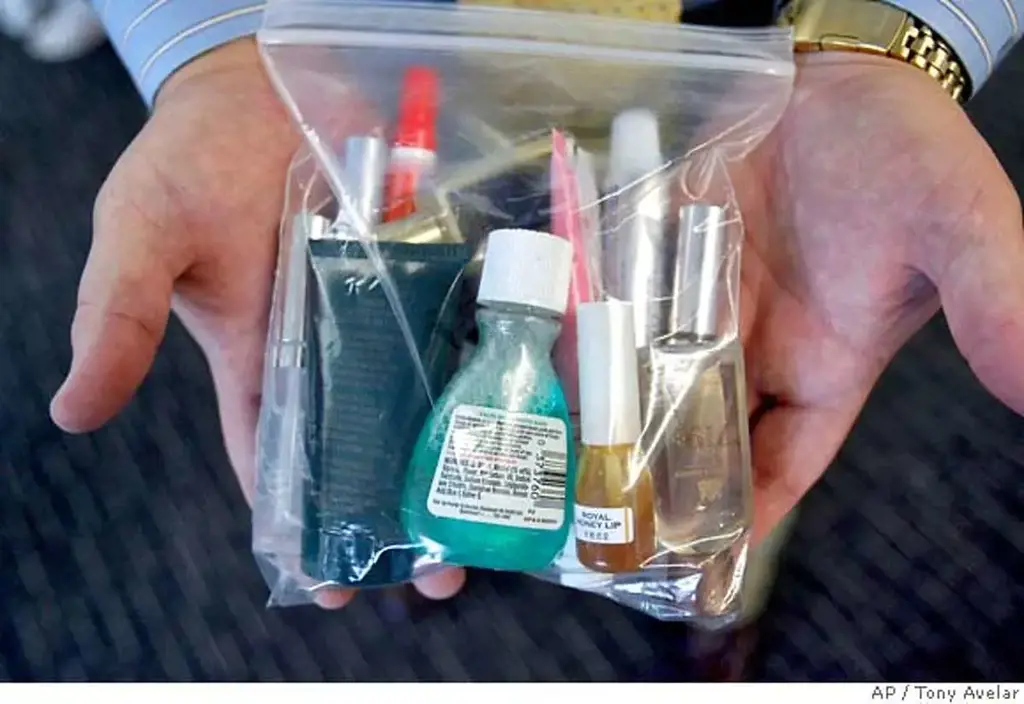
Yes, you can bring liquids on a plane, but there are certain restrictions and regulations you must follow. These restrictions are in place to ensure the safety and security of all passengers.
The general rule is that liquids in your carry-on bag must be in containers that hold 3.4 ounces (100 milliliters) or less. These containers must be placed in a clear, quart-sized resealable bag. Each passenger is limited to one bag of liquids, with each container not exceeding the maximum volume.
The Transportation Security Administration (TSA) has implemented these rules to comply with international aviation security standards. These regulations apply to all airports and airlines operating in the United States.
There are a few exceptions to these restrictions. Baby formula, breast milk, and baby food are allowed in larger quantities exceeding the 3.4-ounce limit. However, these items will need to be inspected by a security officer. It's recommended to inform the officer about these items beforehand to speed up the screening process.
Prescription medications, including syringes and other medical necessities, are also allowed in larger quantities, but again, they must be inspected by a security officer. It is advisable to have a doctor's note or prescription handy, especially for liquid medications.
Liquids purchased from airport stores located beyond the security checkpoints are generally allowed on board. However, it's always a good idea to check with the specific airline regarding their regulations and to keep the receipt with you.
It's important to note that these rules apply to carry-on bags. If you pack liquids in your checked luggage, there are fewer restrictions. However, it’s still wise to double-check airline policies and be cautious about certain items that might be prohibited, such as flammable or explosive materials.
In conclusion, you are allowed to bring liquids on a plane, but there are strict regulations in place. Follow the 3.4-ounce limit and use a resealable clear bag for all liquids in your carry-on. Exceptions are made for baby formula, breast milk, and prescription medications, but they may require additional screening. It's always wise to check with your airline for any specific regulations they may have, especially if you are unsure about any particular liquid item. By adhering to these rules, you can ensure a smooth and hassle-free security screening process at the airport.
Navigating Travel Restrictions: What You Need to Know About Kayaking during the Pandemic
You may want to see also

Are there limitations on the size or quantity of personal care items allowed in carry-on luggage?
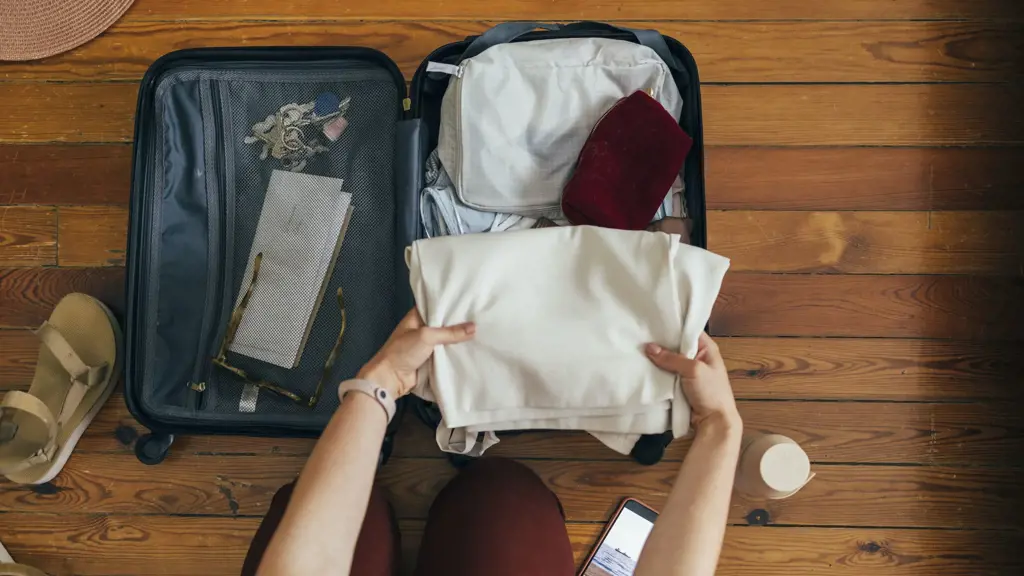
When it comes to traveling with personal care items, it's important to be aware of the size and quantity limitations set by the Transportation Security Administration (TSA) for carry-on luggage. These limitations are in place to ensure the safety and security of all passengers on board. Let's take a closer look at what you need to know about bringing personal care items in your carry-on bag.
Size Limitations:
The TSA has established a rule known as the 3-1-1 rule for liquids, gels, and aerosols. According to this rule, travelers are allowed to bring containers that are no larger than 3.4 ounces (100 milliliters) in their carry-on bags. These containers must fit comfortably in a clear, one-quart-sized plastic bag. Each traveler is allowed only one plastic bag.
Quantity Limitations:
In addition to the size limitations, there are also quantity limitations for personal care items in your carry-on bag. While there is no specific limit on the number of items you can bring, all of these items must fit in the one-quart-sized plastic bag mentioned earlier. This means that you need to carefully consider the number of items you pack and make sure they can all fit in the bag. It's also important to note that only one plastic bag per traveler is allowed.
Exemptions:
There are some exemptions to the 3-1-1 rule. Travelers with medical conditions or disabilities are allowed to bring larger quantities of medically necessary liquids, gels, and aerosols in their carry-on bags. However, these items may be subject to additional screening procedures.
Examples of Personal Care Items:
Personal care items that may fall under the 3-1-1 rule include items such as shampoo, conditioner, toothpaste, lotions, creams, deodorants, and other similar products. It's important to remember that these items should be in containers no larger than 3.4 ounces (100 milliliters) and should be placed in a one-quart-sized plastic bag for screening.
Checked Baggage:
If you are traveling with larger quantities of personal care items, or if you have items that do not meet the size limitations, you may consider packing them in your checked baggage instead. There are fewer restrictions on liquids, gels, and aerosols in checked baggage, but it's always a good idea to check with your airline for any specific guidelines or restrictions they may have.
In conclusion, when it comes to personal care items in carry-on luggage, it's important to adhere to the size and quantity limitations set by the TSA. Following the 3-1-1 rule for liquids, gels, and aerosols will help ensure a smooth and efficient screening process. If you have larger quantities or items that do not meet the size limitations, consider packing them in your checked baggage or exploring any exemptions for medical necessities.
The Impact of Government Travel Restrictions on Tourism and Society
You may want to see also

Are there any restrictions regarding the transportation of sharp objects or weapons on a plane?
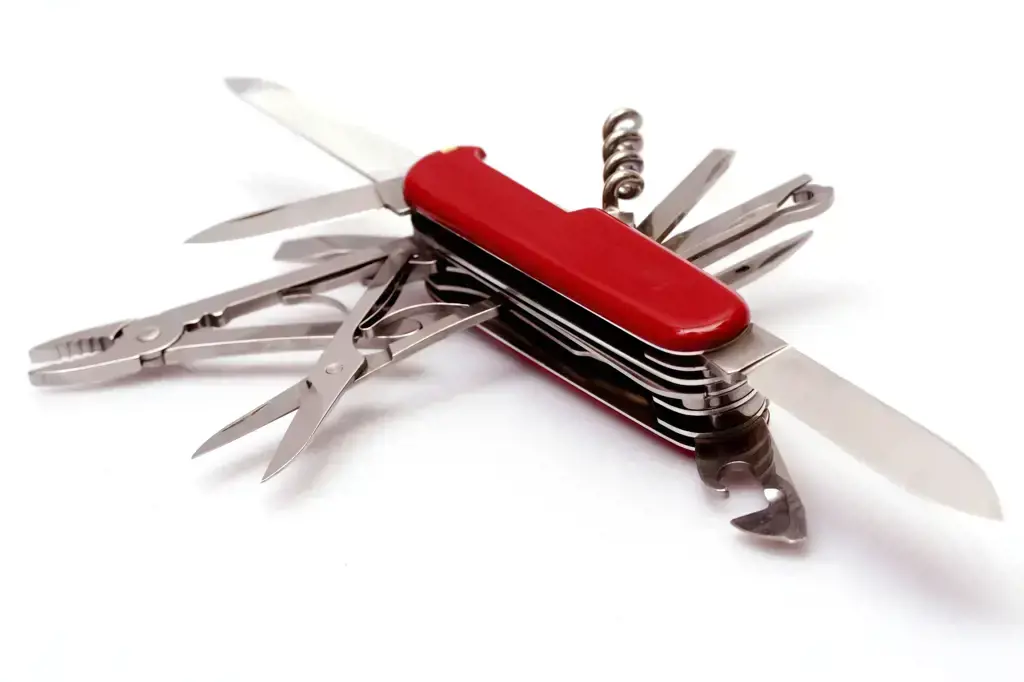
When it comes to air travel, there are several restrictions in place to ensure the safety and security of passengers and crew members. One area where strict regulations are enforced is the transportation of sharp objects or weapons on a plane. These restrictions are in place to prevent potential harm to passengers and crew members and to maintain the integrity of the aircraft.
In general, sharp objects such as knives, box cutters, scissors, and other similar items are not allowed in carry-on bags or on your person when you pass through security checkpoints. These items must be placed in your checked baggage to be transported in the cargo hold of the aircraft. However, there are exceptions to this rule for certain types of knives, such as plastic or round-bladed butter knives and safety razors with disposable blades.
Additionally, there are strict guidelines regarding the transportation of firearms and other weapons on a plane. Firearms, including handguns, rifles, and shotguns, are generally not permitted in carry-on bags or on your person. These items must be declared to the airline and transported in checked baggage. To transport firearms legally, they must be unloaded, securely packed in a locked hard-sided container, and declared to the airline during the check-in process. Certain restrictions may apply, depending on the airline and the destination.
It's important to note that regulations regarding the transportation of sharp objects or weapons on a plane may vary between countries and airlines. It's always best to check with your airline and the relevant authorities before traveling to ensure compliance with the regulations in place.
If you are unsure about a specific item, it's best to contact your airline or refer to the official website of the transportation security administration (TSA) or the civil aviation authority in your country for updated and detailed information.
In summary, there are strict restrictions regarding the transportation of sharp objects or weapons on a plane. Sharp objects such as knives and scissors are generally not allowed in carry-on bags and must be placed in checked baggage. Firearms and other weapons must be declared and transported in accordance with specific guidelines. It's important to familiarize yourself with the regulations in place before traveling to ensure a smooth and hassle-free airport experience.
Air France's Dog Travel Restrictions: Everything You Need to Know
You may want to see also

How does the list of air travel restricted items differ between domestic and international flights?
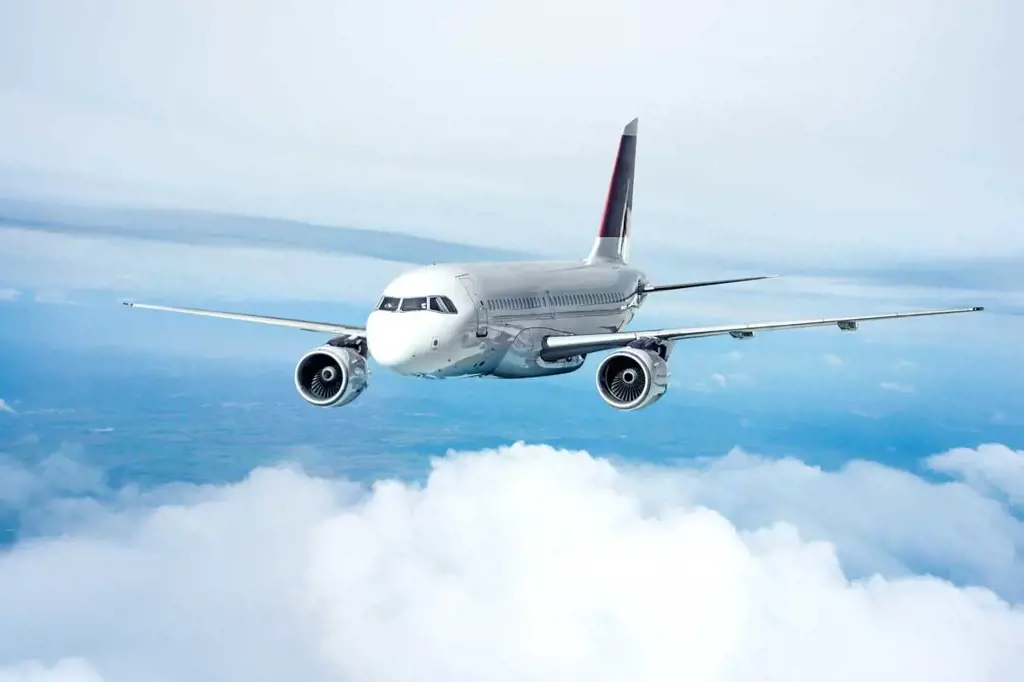
Air travel has become an essential mode of transportation for people all around the world. Whether it is for business or leisure purposes, people often rely on air travel to reach their desired destinations quickly and efficiently. However, when it comes to air travel, there are certain restrictions on the items that passengers are allowed to carry onboard. These restrictions vary between domestic and international flights, and it is important for travelers to be aware of them to ensure a smooth and hassle-free journey.
The restrictions on air travel items are primarily put in place to ensure the safety and security of passengers and airline staff. While both domestic and international flights have similar restrictions, there are certain differences based on the destination and the airline's policies. Let's take a closer look at how the list of air travel restricted items differs between domestic and international flights.
Domestic Flights:
For domestic flights, the restrictions on air travel items are generally less stringent compared to international flights. Passengers are usually allowed to carry a wide range of items in their cabin baggage, as long as they comply with the airline's regulations. Items such as personal electronics, liquids in containers of 3.4 ounces or less, and small pocket knives are usually permitted on domestic flights. However, it is important to note that sharp items, firearms, and explosives are strictly prohibited on all flights, including domestic ones.
International Flights:
On the other hand, international flights have stricter restrictions on air travel items. This is mainly due to the various customs and security regulations imposed by different countries. To ensure a smooth transit through international borders, passengers are required to follow the guidelines set by their airline and the destination country. In addition to the prohibited items mentioned above, international flights often have additional restrictions on liquids and gels, as well as specific items that are deemed illegal in certain countries.
For example, passengers traveling on international flights are usually limited to carrying liquids and gels in containers of 3.4 ounces or less, all of which must be placed in a clear, quart-sized bag. This is commonly known as the 3-1-1 rule and is strictly enforced at all international airports. Furthermore, certain countries have specific restrictions on items such as fruits, vegetables, plants, and animal products to prevent the spread of pests and diseases.
It is important for passengers to research and familiarize themselves with the specific restrictions of their destination country before traveling. This can typically be done through the airline's website or by contacting the embassy of the destination country. Ignorance of these restrictions can lead to delays, fines, or even confiscation of items at the airport.
In conclusion, while there are some similarities in the restrictions on air travel items between domestic and international flights, there are noticeable differences. Domestic flights tend to have more lenient restrictions, allowing passengers to carry a wider range of items in their cabin baggage. On the other hand, international flights have stricter regulations to comply with customs and security requirements of different countries. It is crucial for travelers to familiarize themselves with these restrictions to ensure a smooth and hassle-free journey.
Understanding the Current Travel Restrictions in Luxembourg
You may want to see also
Frequently asked questions
Yes, you can bring medication on a plane. It is recommended to keep medication in its original packaging and bring a copy of the prescription if possible. If it is a liquid or gel medication over 3.4 ounces, it will need to be declared and may be subject to additional screening.
Yes, laptops and other electronics are allowed on a plane. However, they will need to be screened separately at the security checkpoint. It is also recommended to keep them easily accessible in your carry-on bag for easy inspection.
It is not allowed to bring firearms or any type of weapon, including replica or toy weapons, on a plane in your carry-on or checked bags. However, you can transport firearms and ammunition in checked baggage if they are properly declared and packed in a locked hard-sided container.
Yes, there are restrictions on bringing liquids on a plane. In carry-on bags, all liquids, gels, and aerosols must be in containers of 3.4 ounces (100 milliliters) or less and placed in a clear, quart-sized bag. However, you can bring larger quantities of liquids in your checked bags.
Yes, you can bring food on a plane. Solid food items are generally allowed in carry-on and checked bags. However, certain items like liquids, gels, and spreads may be subject to the 3.4-ounce rule and need to be packed in a clear, quart-sized bag. It is also recommended to check with the specific airline for any additional restrictions on food items.







